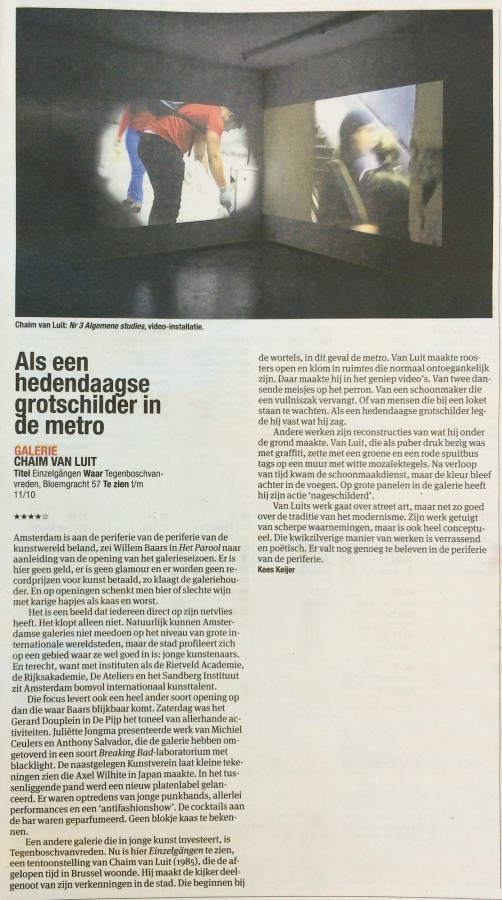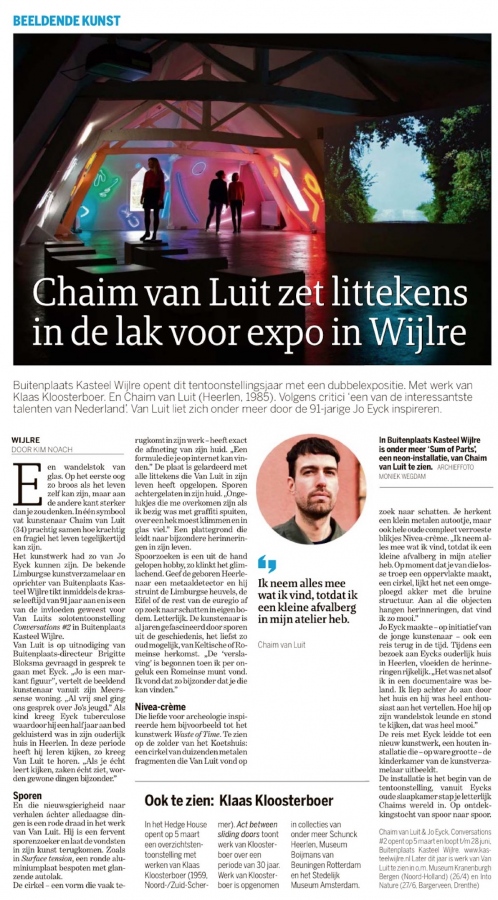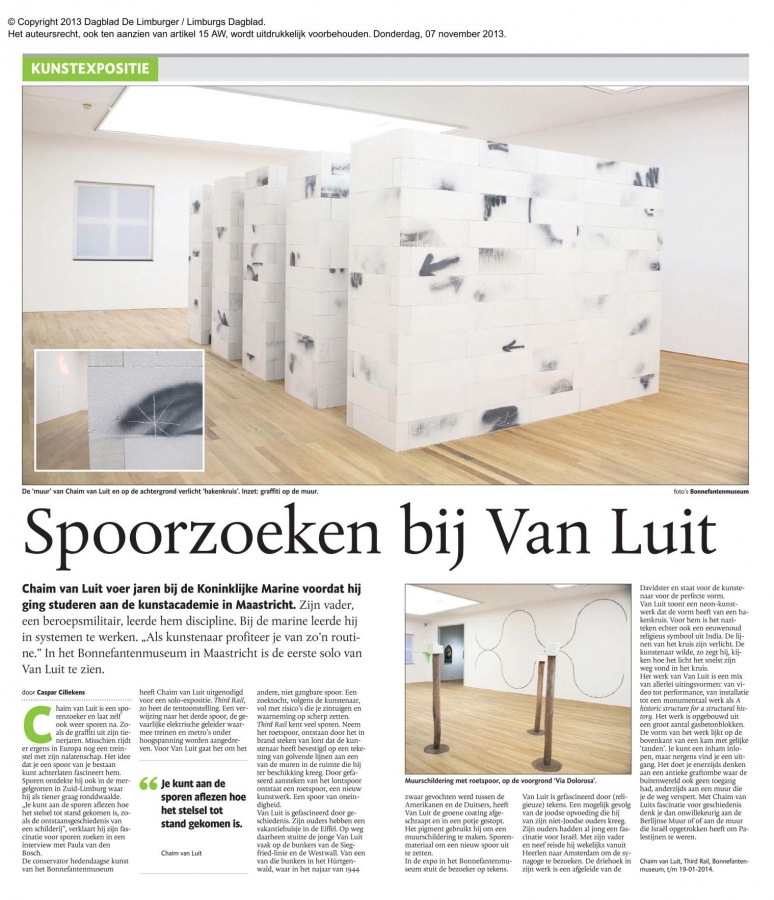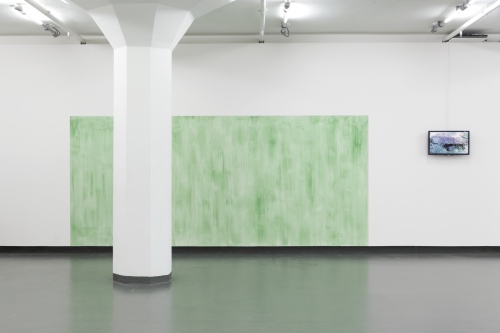-
Text/Press, 2011 - 2020
-
Dagblad de Limburger
29 Februari 2020, by Kim Noach
-
Chaim van Luit
Via Lucis II
Meessen de Clercq, Brussels
March 23 - May 5, 2018
With a Latin title,Via Lucis, which can be translated as ‘luminous path’, Chaim van Luit addresses fundamental themes such as time, light and space in his second solo exhibition at the gallery.
A tireless surveyor, an inquiring mind, van Luit makes his work grow in his studio as much as in the countryside surrounding it. Chaim van Luit’s work relies on the notion of harvesting. Harvesting artefacts, harvesting data, harvesting of all kinds, in order to put together a puzzle which ultimately provides us with the image of a vast landscape. By welcoming the visitor with a mirror onto which is glued an old comb, the artist poses the question of identity and point of view from the outset. Opposite,Circumscribe, the large neon circle shows the personal scale of the artist who is defining the limits of his body. How can weavoid seeing a metaphor in this? That fragile line, that protective perimeter, reminds us that Man can hope to touch the sky, but also reminds us that he has his feet on the ground, and can easily bite the dust.Wouldn’t that be the story of Icarus? Being tempted to soar through the heavens but being brought back down to end in burial. How far should one go?
Not lacking in humour, we find these two aspects again in Lost and found pigeon rings.The rings of carrier pigeons arranged in a rainbow gradation come from the items found by the artist during his many outings with his metal detector. For years, he hasbeen criss-crossing his home region and collecting these numbered coloured rings that enable identification of these trained birds which fly colossal distances as they attempt to reach an extremely precise destination.The presence of buried ringsnevertheless demonstrates their abrupt end and the failure of the mission.
Van Luit digs to unearth what is buried, to extract it from oblivion.The work Chain of thoughts consists of tens of metal wires exhumed using the same method and tied together to measure the height of the exhibition space.These elements taken individually have no meaning, but putting them one after the other gives a measurement. Likewise with Stone bridge consisting of core samples of marble and travertine which, placed on the ground, become a surveyor’s or archaeologist’s marker.
The title of the video made in collaboration with Joep Vossebeld, Legato, represents the way of playing successive notes, linking them together, so that there is no silence between them.The video shows disparate images gleaned on the artist’s travels,images taken inside a cave, in a field, on a road, in a forest, whereas the soundtrack is the recording of a voicer tuning theorgan in a church.The shots are agitated until there is a moment of calm, a stable shot, which corresponds to the momentwhen the voice finds the right note. Image and sound are then in optimal harmony.This wish to combine two different realmsor universes can be found again in Structure, Construction; a marble sculpture which is the reproduction of moulted stag antlersfound in the forest.Van Luit is fascinated by the organic nature of the antlers, which grow back each year and translate thisshape into marble using an advanced technique. Or how to combine nature and machine.
As an artist van Luit has an unusual background - a military career lasting several years - which occasionally resurfaces as
can be seen in Spear, a wooden stick painted with the colours of the surrounding space. Under its minimalist camouflage, thisobject disappears, leaving the idea. Erasing the object to highlight the action of painting to exploit the transition between object and wall.As with the canvasses in the series Comb (horizontal/vertical) painted in a monochromatic progression which are reminiscent of certain issues highlighted by artists like Ryman and Opalka. Recalling that painting is an association between the material and a medium, the artist shows how important light is to perception. Depending on the viewpoint, the viewer perceives a ghostly shape recorded in the material only due to the alternation of the direction of application of the paint (vertical or horizontal).According to van Luit, monochrome is not an end in itself, but a means of achieving repetition of an action until it reaches perfection.The idea is to show the painting in a degree of bareness, and encourage the viewer to look closely, look from far away, look at an angle, and choose multiple viewpoints. -
Chaim van Luit
Via Lucistegenboschvanvreden, Amsterdam
November 24, 2017 - January 13, 2018Some scientists think it is possible to travel through time. Usually, when we consider the potential scenarios for time travel, we encounter the idea that the future time traveller interferes with the past, and that that past is predestined, as it were, to bring about the future. Is this a result of the ‘prior knowledge’ that we have? In his solo presentation ‘Via Lucis’, Chaim van Luit (1985, Heerlen, NL) speculates about the past, present and future by interconnecting various time lines in parallel universes.
Anyone who sees his spectacular yet intimate installation of works in diverse media can endorse what scientists claim: time travel is possible!
The surroundings of Maastricht, where Chaim van Luit lives, are a veritable treasure-house of artefacts that attest to the presence of ancient peoples such as the Celts, the Eburones and the Romans. Nearly every day he happens to cross some important trading route of the Romans in South Limburg. Van Luit followed the traces of this route, and the 'discoveries' that he made while doing so make up the point of departure for the exhibition titled ‘Via Lucis’ (Way of Light). Time and history are linked by his 'shedding of light' on these finds, which include not only ancient coins, insects sculpted in marble and hairs of the mammoth, but also ideas. A photographic work in the exhibition shows, for instance, a spider which, caught in a drop of resin from a conifer roughly forty million years ago, remained preserved for eternity. Dangling above this ancient specimen captured in amber is a second - modern day - spider.
The exhibition functions as one large installation containing separate elements that relate to each other in their various levels of meaning. As Van Luit's friend the artist Joep Vossenbeld wrote to him: “Do you know what I think? I think that it's an aquaduct that you're working on, a construction meant to connect a source and an estuary. A 'mental' aquaduct, its source being here in South Limburg and its outlet in Amsterdam.” Van Luit seeks and then finds: his fascination is for the things we don't see, things that play beneath the surface and which, once they are exposed, can simply dissolve in the flow of time.
The work of Chaim van Luit is conceptual, in the sense that it explores the relationship between an idea and the form that a work can assume. His frequently poetic images betray an observational stance and a concern for the world that lies beneath the surface of things. Like his ideas for new work, the materials used by Van Luit seem to come out of nowhere, due to an intuitively investigative approach that is always geared to discovery.
Scattered about on a table are fragments of a urinal - an antique model, from 1942, produced by the famous Sphinx factory in Maastricht. The pieces of porcelain lie on a blue cloth; their shadows have been captured by way of a photographic process. Appearing almost inconspicuously among the remnants of the urinal is a fly, in marble, an archeological gem from Egypt. Duchamp begins to whirl about here, not only with connotations of antiquity but also today's hygienics. Time travel is possible!
-
Herbstnebel
Meessen de Clercq
Januari 9 - Februari 7, 2015
Dutch artist Chaim VAN LUIT (b.1985), who recently moved to Brussels, is presenting a work in the Wunderkammer with the enigmatic name of Herbstnebel. This word (meaning Autumn Mist) was the codename used by the German Army to designate the Ardennes Counteroffensive (Battle of the Bulge), Hitler's last throw of the dice to counter the Allied advance on the Western Front. Chaim van Luit is an artist, although he was also in the navy for four years. This atypical career has allowed him to sail many seas and appreciate the concept of vastness. As an artist, he now explores blank spaces and probes places rich in silent memories: wasteland, caves, subway corridors among others. One could say that he has a constant urge to reveal whatever is hidden, concealed from view.
To produce 930°c (title of the work, which refers to the melting point of brass), van Luit bought a metal detector and went to places in Belgium and Germany where the fighting took place in 1944. He found a large amount of scattered metal items, shell cases, aircraft parts or belt buckles. His idea was not to keep them as such, but to use them in a process of transformation, to push the boundaries of the object, to convert them from the status of items buried in the soil for 70 years to the status of unidentifiable elements fused into a new object, with a new charge. A charge which is no longer historic but symbolic. Which is why he chose the door-handle from his house. This item enables a door to be closed on one space, and opened on a different space. Grasped every day, it embodies concepts of handling (or use, one might say), boundary (between the outside world and the intimacy of home), transition between two heterogeneous but complementary spaces, opening onto a new horizon, passage, territory, of the house. The presentation brings archaeological museums to mind, emphasising the idea of ruin. In addition, by positioning the handle slightly higher, on an acoustic mat, the artist accentuates the contrast between the weight of the metal and the lightness of what might be referred to as a relic. He also reminds us that these metal fragments were discovered by listening very carefully; the past rises again if we pay attention to it, if we are prepared to listen. Inexhaustible material for van Luit, it is there to be transformed and given a new interpretation.
Ultimately, one can interpret this door-handle made of various metals excavated from misty borders as a powerful commemorative monument. -
NRC, by Hans de Hartog Jager, van Luit speelt met tijdzones, 15-01-2015
-

Metropolis M no.6 2014, by Sam Steverlynck
-

Het Parool by Kees Keijer, Als een hedendaagse grotschilder in de metro, 1 oktober 2014
-

-
Buy Publication - Third Rail - Bonnefantenmuseum - 2013 [LINK]
Watch Publication - Third Rail - Chaim van Luit - Bonnefantenmuseum - 2013 [LINK]
Texts by Pietje Tegenbosch and Paula van den Bosch
-
De Volkskrant by Marina de Vries, In de beperking bewijst zich Chaim van Luit, 14 november 2013
-
Dagblad de Limburger/ Limburgs Dagblad by Caspar Cillekens, Spoorzoeken bij Van Luit, 7 november 2013
-
La Libre, Jeux de perception, 11 october 2013
-
De Volkskrant by Stijn Huijts, Kunstenaars op komst, 19 april 2013
-
Artolive jong talent awards 2011 by Paula van den Bosch, november 2011
Het werk van Chaim van Luit bezit de prettige eigenschap dat je niet meteen weet hoe je het moet benoemen. Het zijn geen schilderijen, geen sculpturen en het verzamelbegrip installatie voldoet al evenmin. Laat ik het ruimtelijke voorstellen noemen met een picturale en filmische inslag. Van Luit heeft een rij witte latten gelijkmatig tegen de wand geplaatst. Tussen de latten zien we een kleurige gloed op de wand, veroorzaakt door de fluorescerende verf (onzichtbaar voor de kijker) op de achterkant van de latten. De werkelijke ruimte wordt zo een schilderkunstige illusie. Aan de binnenkant van een kamervullende, ritmisch verzaagde, dubbelwandige lampenkap ontstaat een fraai licht- en schaduwspel. De illusie van een oneindige golfbeweging houdt de aandacht gevangen. Knap scheert van Luit in deze werken langs de afgrond van loos designobject enerzijds en installatieve nietszeggendheid anderzijds. Van Luit houdt zich bezig met elementaire zaken omtrent waarneming en is trefzeker in opzet, keuze van materialen en uitwerking. Verrassend goed.
cvl - 2025©
























